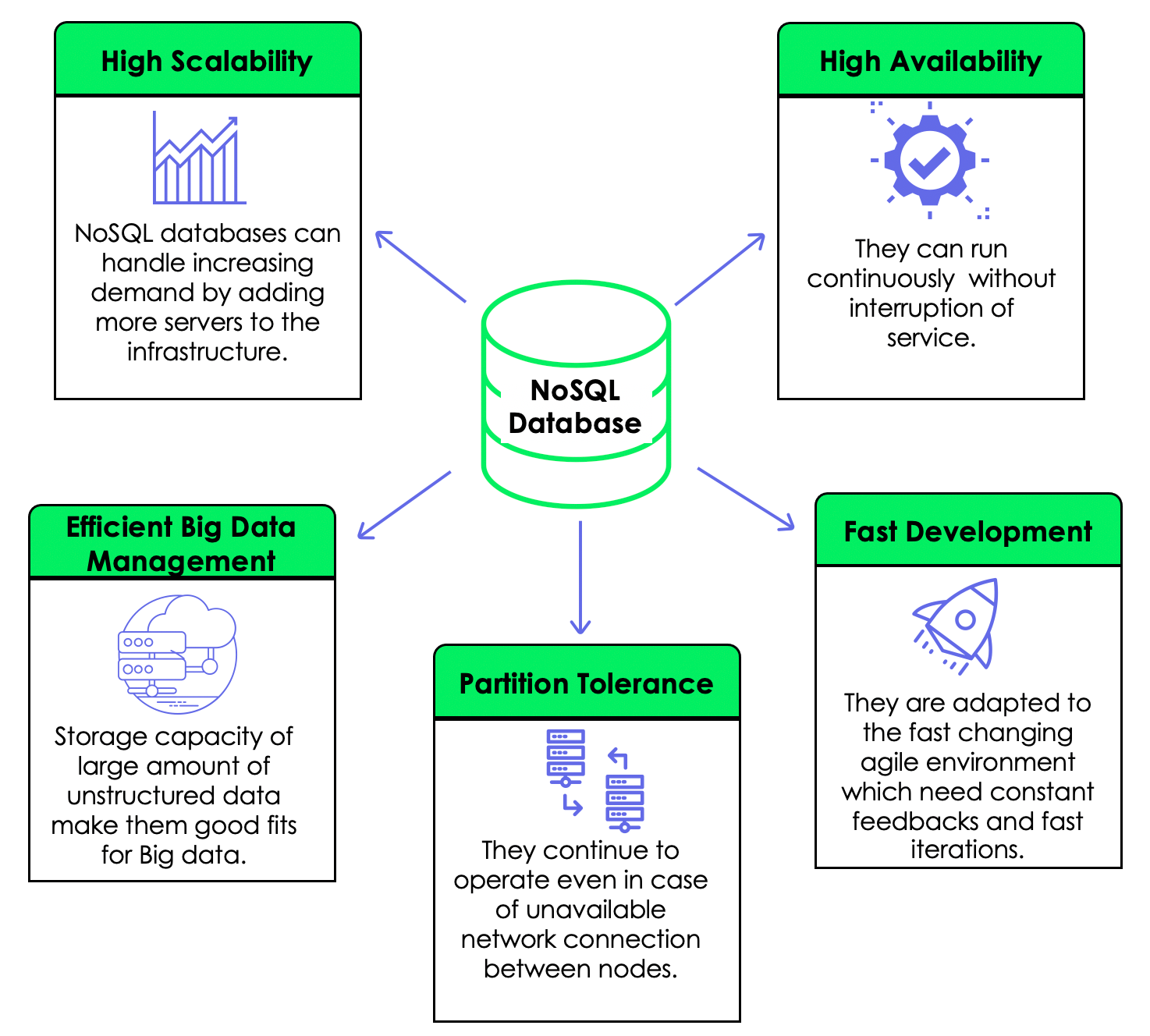What is NoSQL?
NoSQL, short for “Not Only SQL,” is a family of database management systems that deviate from the traditional relational database model. Unlike SQL databases, NoSQL databases are designed to handle unstructured or semi-structured data efficiently. They offer flexible schema designs, horizontal scalability, and high performance, making them a preferred choice for many Big Data analytics applications.
Types of NoSQL Databases
NoSQL databases come in various types, each catering to specific use cases and data models. Here are the four primary types of NoSQL databases:
Document Store: Document-oriented databases, like MongoDB and CouchDB, store data in JSON-like documents. These databases are well-suited for storing data that doesn’t fit neatly into rows and columns, such as product catalogs, user profiles, and blog posts.
Key-Value Store: Key-value stores, including Redis and Amazon DynamoDB, store data as key-value pairs. They are incredibly fast for read and write operations, making them ideal for caching and real-time applications.
Column-family Store: Column-family stores like Apache Cassandra and HBase organize data into column families, allowing for efficient storage and retrieval of vast amounts of data. They excel in use cases requiring high write throughput and scalability.
Graph Database: Graph databases, such as Neo4j, specialize in storing and querying data that has complex relationships, such as social networks, recommendation engines, and fraud detection systems. They represent data as nodes and edges, making it easy to traverse and analyze relationships.
Advantages of NoSQL Databases in Big Data Analytics
Now that we’ve covered the types of NoSQL databases, let’s explore why they have gained popularity in Big Data analytics:
Scalability: NoSQL databases are horizontally scalable, meaning you can add more servers to your cluster as your data grows. This allows you to handle massive datasets and high traffic loads seamlessly.
Flexible Schema: Unlike rigid schemas in SQL databases, NoSQL databases offer schema flexibility. You can easily adapt your data model to changing requirements without downtime or complex migrations.
High Performance: NoSQL databases are optimized for specific use cases, resulting in superior performance for tasks like real-time analytics, data warehousing, and streaming data processing.
Geospatial Support: Many NoSQL databases provide built-in support for geospatial data, making them ideal for location-based analytics and applications.
Fault Tolerance: NoSQL databases often come with built-in fault tolerance mechanisms, ensuring data integrity and availability even in the face of hardware failures.
Cost-Effective: NoSQL databases can be more cost-effective than traditional SQL databases, especially when dealing with large-scale data.
Use Cases for NoSQL Databases in Big Data Analytics
NoSQL databases find applications across various industries and use cases:
E-commerce: Document stores are used to manage product catalogs and customer profiles, while key-value stores can power real-time inventory management.
Social Media: Graph databases are ideal for analyzing social networks, identifying influencers, and recommending connections or content.
IoT: NoSQL databases can efficiently store and process data from IoT devices, enabling real-time monitoring and analysis of sensor data.
Log and Event Data: Column-family stores are well-suited for storing and analyzing log files, event data, and time-series data.
Personalization: NoSQL databases help deliver personalized experiences by efficiently storing and retrieving user preferences and behavior data.
Challenges of NoSQL Databases
While NoSQL databases offer numerous advantages, they are not without challenges:
Consistency vs. Availability vs. Partition Tolerance (CAP): NoSQL databases adhere to the CAP theorem, which states that a distributed system can provide at most two out of three guarantees—consistency, availability, and partition tolerance. Depending on the database type, you may need to make trade-offs.
Lack of Standardization: Unlike SQL, which has a well-defined standard, NoSQL databases vary significantly in terms of data models, query languages, and APIs. This lack of standardization can lead to a steeper learning curve.
Data Integrity: With flexible schemas, ensuring data integrity can be more challenging in NoSQL databases. Developers must implement data validation and error handling at the application level.
Complex Queries: Some NoSQL databases may struggle with complex, ad-hoc queries that are common in data warehousing and business intelligence applications.
Conclusion
In the era of Big Data, NoSQL databases have emerged as a powerful tool for organizations seeking to harness the potential of vast and diverse datasets. Their flexibility, scalability, and performance make them well-suited for a wide range of Big Data analytics use cases. However, it’s crucial to choose the right type of NoSQL database for your specific requirements and to understand the trade-offs involved.
As businesses continue to generate and analyze ever-increasing volumes of data, NoSQL databases will likely play an even more significant role in shaping the future of Big Data analytics.


